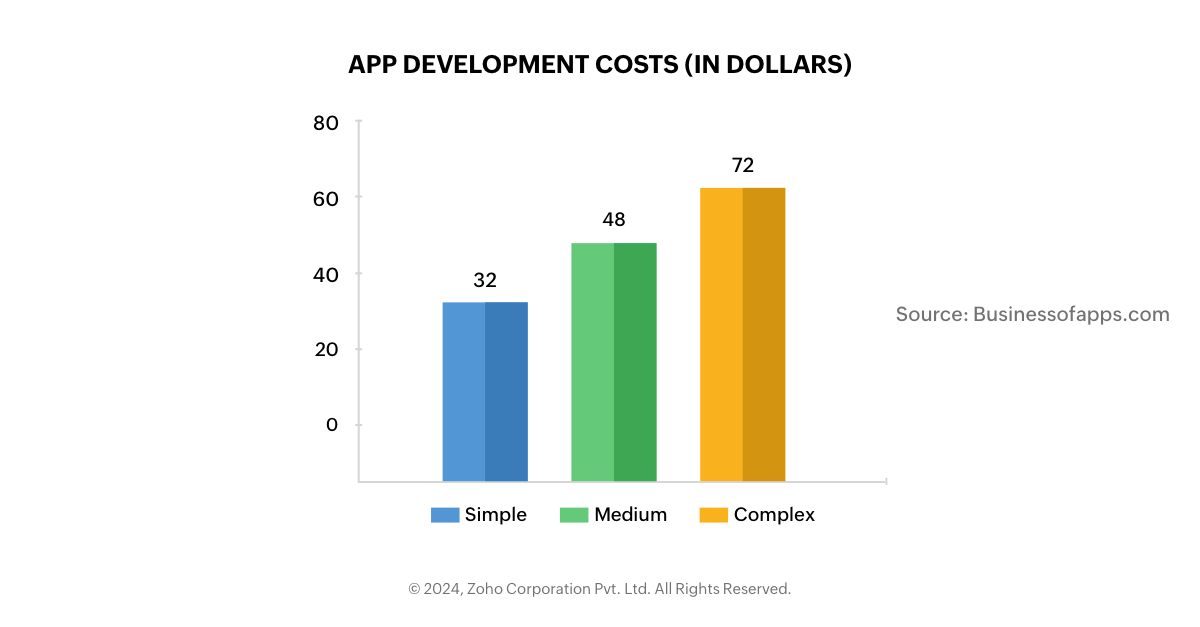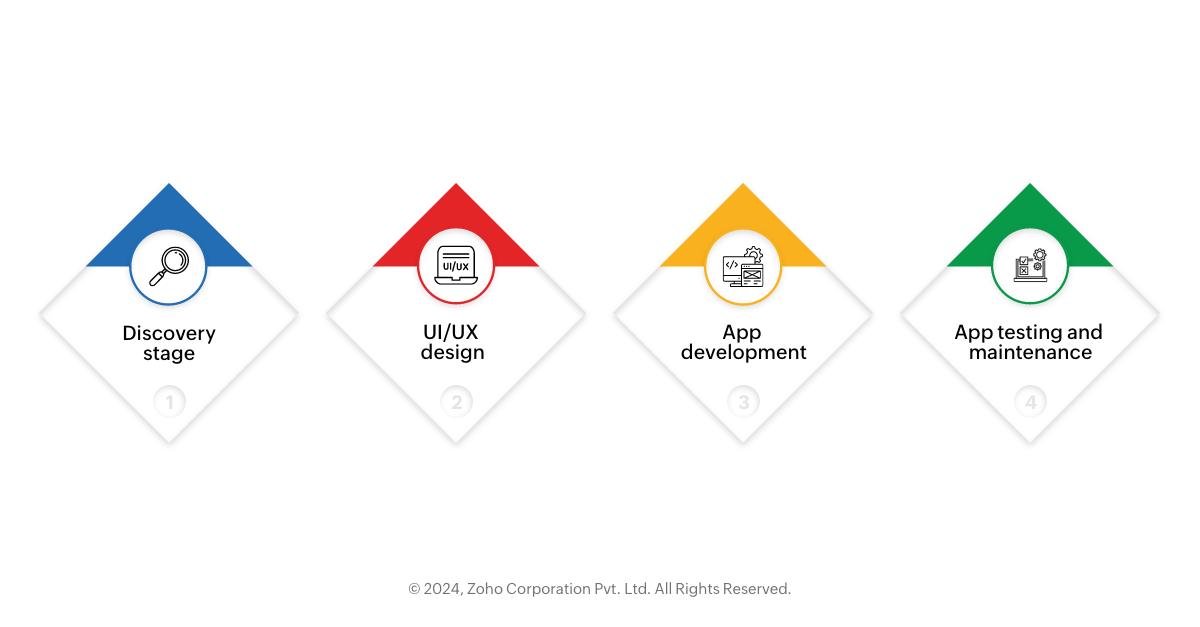- HOME
- Know Your Tech
- App development cost in 2025
App development cost in 2025
- Last Updated : April 15, 2025
- 5.6K Views
- 9 Min Read
How much will it cost to build an app in 2025?
App development cost is one of the key factors that not only determines the software development approach but also the quality of applications delivered.
Understanding application development costs is crucial for businesses planning to integrate web or mobile applications into their digital transformation strategies. With mobile app revenue increasing every year, it’s clear that apps are key to enhancing the customer experience, boosting revenue, and increasing retention rates.
Web or mobile app development costs depend largely on the app’s type or category. For instance, the cost of developing a simple app like a calculator or flashlight is usually cheaper compared to developing a more complex app like a social media platform or a gaming app.
However, when businesses aren’t able to make the right financial decisions related to these applications, the app development process often gets stuck in the pipeline. To simplify this decision-making process, businesses need to understand the many factors that can influence their final app development cost.
What do surveys indicate?
To estimate application development costs, businesses often use the following formula:
Total development time * Hourly rate for development = Cost of app development
The total app development time includes planning, feature development, UI changes, and more. According to Business of Apps, the cost of developing a simple app, featuring basic functionalities like a login system, user profiles, and a dashboard, ranges between $16,000–$32,000.
Medium complexity apps, incorporating features such as user engagement and app monetization, social media integration, payment gateways, audio/video streaming, and user privacy, typically cost between $32,000–$48,000.
On the higher end, complex apps that integrate the latest technologies such as AR/VR, AI, and machine learning, with multi-language support and high-end data logic, start at around $72,000.

All that being said, prices do not necessarily guarantee the quality of your app development. Sometimes, cheaper development costs may save you money, while higher costs may just be for the name of the company.
App development cost by platform and industry
When developing apps, businesses have to think about factors such as the market share of Android and iOS. They also need to consider who their target audience is, the range of devices available, app services, and, most importantly, the technical implementation.
App development for these platforms requires different programming languages, utilizing different development tools and APIs.
Here's the estimated app development cost per app operating systems:
Type of app | Average cost of development |
iOS | $25,000 to $250,000 |
Android | $20,000 to $250,000 |
Windows | $20,000 to $200,000 |
While basic web and mobile app development cost remains consistent across industries, specific functionalities can significantly affect the overall cost. Based on some research, industry-specific app development costs are as follows:
Industry | Approximate cost of development |
Healthcare | $10,000 to $70,000 |
Education | $15,000 to $100,000 |
Retail | $7,500 to $50,000 |
Media & entertainment | $5,000 to $70,000 |
Social media | $10,000 to $50,000 |
Breaking down application development costs
The question “how much does app development cost?” is a tricky one since there is no fixed price to develop an application. Each step in the app development process impacts your final app cost, so it's vital to make decisions carefully.

Here’s a detailed breakdown of these stages and a comparison between traditional and low-code development approaches.
1. Discovery stage
The pre-research, or discovery stage is the base for your entire app development lifecycle.
This stage covers:
Conducting market research
Studying the target market and competition
Visualizing the app
Determining app capabilities
Setting the product roadmap
Risk assessment
Figuring out KPIs
Setting a timeline
The discovery stage in software development marks the initial analytical phase where the primary goals, tasks, and requirements of the product are defined. During this stage, stakeholders gather data, identify key risks, and outline challenges to be addressed throughout the development process.
Ideally, if your project has minimum requirements, the cost is a fixed amount. However, if the application is complex, the discovery phase will also become a more detailed and in-depth exercise.
Factors influencing development costs in the discovery stage
In-house development vs. outsourcing
The first thing you need to decide is whether to develop an app in-house or outsource the process to a third-party development agency. Choosing between in-house development and outsourcing impacts your initial cost estimation.
Cost of hiring a developer, and even outsourced development costs can be hourly or fixed, and may increase with changes in later stages. In-house development is relatively cheaper and gives you the flexibility to alter budgets as conditions change.
Number and complexity of features
The number and complexity of features you want to implement directly impacts app development costs. The more complex the features, the higher the cost and longer the development time.
Some of them, like a web portal used for managing the app, can take up half of your app budget and reach thousands of dollars in implementation. Most businesses define a minimum viable product (MVP) at this stage, with initial costs depending on essential features.
According to Business of Apps, 51% of companies allocate up to $5,000 for formulating an initial concept and conducting research. Another 22% exceed this, investing $10,000, while 14% allocate between $10,000 and $25,000.
2. UI/UX design
The first thing users notice when they open your app is the design. It's your chance to make a good first impression, or you risk losing their interest right away. The UI/UX design stage provides a preview of the app’s look and user journey.
While there’s a set amount of time and cost involved in finalizing the design, translating it into the app depends on its complexity. Simple UI elements require less coding effort compared to complex ones, and that affects your overall cost.
Average app design cost would be somewhere between $3,000–$30,000, depending on the app complexity.
Instead, low-code platforms simplify this stage for you with a drag-and-drop interface and customizable elements, significantly reducingdevelopment time and costs.
3. App development
The core stage of app development, where most of the budget is invested, involves the following factors:
Infrastructure and APIs
App features often rely on web-based APIs. Integrating payment gateways and third-party applications increases development costs. If you require a backend for your app's functionality management, then it will be more expensive due to complex coding.
Development approach
You can either develop a native or hybrid app depending on the requirements, and the chosen development approach influences the final app cost.
Native app development creates an application for a specific platform: iOS or Android. Since native apps require separate development for each operating system, to enhance user experience, they are built according to specific guidelines and device hardware. As such, the development process of these apps requires intensive programming and a significant amount of time.
If you want your app to reach a large audience, cross-platform or hybrid app development is a good option. Hybrid apps are developed to work on multiple operating systems, which means you only need to develop one app for various devices. The main advantage of hybrid apps is their lower development cost.
Simple features like push notifications cost less than $5,000, while web portal development for app management ranges from $5,000 to $25,000.
Learn more about app development here.
Here's an approximate development time taken to build a few complex features:
Feature type | Approximate development time (in hours) |
Hardware features (internet, bluetooth, NFS, etc.) | 30–100 |
User login | 10–70 |
User engagement (SMS, push notifications, email, etc.) | 25–145 |
Geolocation | 10–150 |
Payments | 20–200 |
Cross-device synchronization | 20–200 |
Even though development hours for each feature vary significantly in traditional app development, low-code platforms, on the other hand, allow for single app development, automatically delivering native apps for different OS and web compatibility. They also offer one-click deployment and built-in API integrations, which help reduce time, effort, and costs.
4. App testing and maintenance
Testing and maintaining your app post-development is crucial to ensure performance before launch. This part is often overlooked and might create confusion. You may have to spend a lot more money even after your app is launched.
Expenses don't stop after app deployment and launch, so it's important to understand how much it costs to maintain an app and budget accordingly for ongoing support.
App maintenance consists of:
Bug fixing and quality assurance
Code optimization
Implementation of new features
Stability and performance improvements
Support of the latest version of third-party services
Upgrade to the latest OS versions
According to some studies, the cost for maintaining the app can be around 15%–40% of the app development cost, for the first year after deployment.
With low-code platforms, maintenance and testing are simplified. You can quickly fix bugs without complex coding, and features like application diagnostics and automatic backups help you identify and resolve issues easily.
Now that we know the cost based on each stage of app development, let's take a look at the factors that affect app development cost in general.
Key cost factors in app development
Several elements, including the composition and location of the team, the app's complexity, and the development platform and tools chosen, can impact your budget.
By considering the following factors, you can estimate the resources required better and avoid unwanted expenses:
Development team composition
A typical team includes project managers, UI/UX designers, app developers, and QA testers, and your cost might vary based on the team size and expertise.
Geographic location of the development team
Development costs also vary by region. When compared, the cost to hire experienced developers from America, Europe, or Asia will be very different. Outsourcing to regions with lower labor costs can reduce your overall budget.
App complexity and features
The complexity and features of the app play a crucial role in determining the cost. Basic apps with minimal features will cost you less, while complex apps with advanced functionalities like AI, AR/VR, and machine learning are more expensive.
Development platform and tools
Your choice of development platform and tools also affects costs. Native app development for multiple platforms is costlier than using cross-platform or low-code development tools.
Post-launch support and maintenance
Ongoing support and maintenance are essential for app success. You will have to continuously invest in regular updates, bug fixes, and feature enhancements.
App marketing costs
The cost of marketing an app is a hidden expense. The cost varies based on factors like your target audience, app category, location, and the size of your existing customer base. Usually, an app marketing company can charge you anywhere from $35,000 to $65,000.
Unfortunately, despite careful planning, execution, and spending a significant amount of money, many web and mobile apps fail to succeed.
Cost of app development in different countries
Some of the well-known countries for app development include the USA, Canada, countries in South America, the UK, Ukraine, India, Southeast Asia, and Australia.
Based on a survey by Goodfirms, below is the table that indicates how much a mobile app developer charges hourly in different countries:
Region | iOS (Avg. $/Hr.) | Android (Avg. $/Hr.) | Cross-platform (Avg. $/Hr.) |
Canada | 90–120 | 80–140 | 90–120 |
USA | 60–120 | 60–120 | 60–130 |
Latin America | 28–90 | 28–90 | 40–160 |
UK | 60–75 | 60–75 | 55–75 |
Europe | 35–55 | 35–55 | 30–50 |
Ukraine | 40–78 | 38–60 | 40–78 |
South Africa | 45–80 | 40–80 | 40–80 |
India | 22–90 | 15–25 | 20–30 |
Southeast Asia | 23–55 | 30–45 | 30–45 |
Asia | 25–35 | 20–30 | 25–35 |
Australia | 90–120 | 100–120 | 90–120 |
The cost of app development varies based on factors like the app's complexity, development team composition, geographic location, and chosen development platform. While traditional development methods can be expensive and time-consuming, low-code platforms offer a cost-effective and efficient alternative.
By understanding the various factors influencing app development cost, you can make informed decisions and achieve your digital transformation goals. Investing in web or mobile app development is definitely crucial for staying competitive in the market, and choosing the right development approach can significantly impact the overall cost and success of your app development project
For businesses looking to build powerful, scalable, and cost-effective apps, consider low-code platforms. They are a smarter option that enable rapid development, reduce costs, and provide the flexibility needed to adapt to market needs.
Click below to delve into the world of application development.
 Bharath Kumar B
Bharath Kumar BBharath leads the Marketing and customer success initiatives of Zoho Creator.
He has over 12 years of professional work experience across SaaS, ERP & Telecom domains. Loves travel, playing badminton and yoga. He believes in keeping things simple.



